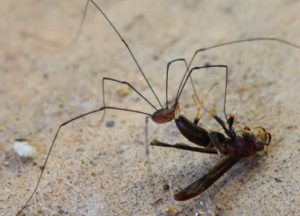

by Lydia Holley June 20, 2022
Granddaddy long legs are one of the easiest creatures to identify, with lengthy appendages on a round, tick-like body. The “grand” part of their name is usually left off and most people just call them daddy long legs, although they are also known as harvestmen.
Even though they have eight legs, and people call them spiders, they are not spiders. They are related to spiders but daddy long legs do not have the segmented bodies spiders have, nor do they weave webs. They belong to the Opiliones order.
You may have heard the tale of their being the most venomous spider around, but in reality, they secrete only enough toxin for a small predator.
The most interesting fact about granddaddy long legs is that they smell and breathe through their legs with specialized holes called spiracles. Which is odd placement, because daddy long legs can lose their legs but they do not grow back. (They cannot live if they lose both of the two legs which hold the spiracles, however.) Sometimes the detached leg will continue to twitch, a mechanism used to confuse its predator. Daddy long legs will actually drop their legs—no need to pull them off—as a means to escape predators.
If you watch daddy long legs closely, you will see that they always keep three legs on the ground as they are walking. This is called the alternate tripod gait. However, they can modify their stance to walk even when they are missing up to three legs. According to entomology researcher Ignacio Escalante at the University of California, Berkeley, daddy long legs have a 60% chance of losing a leg during its lifetime. Scientists are studying the way daddy long legs uses its legs for enhanced prosthesis and robotics.
Mostly eating dead insects and worms, daddy long legs are scavengers. I once saw one very gingerly approach a dead brown recluse spider. When the daddy long leg was certain the spider was dead, he proceeded to eat it. By the next morning, there was nothing left of the spider, although I did not actually witness the daddy long leg eating the spider’s entire skeleton.
You may find daddy long legs clustered together. Scientists do not know why they do this. They hypothesize it has something to do with warmth, humidity, or predator avoidance. I suppose they believe there is strength in numbers. Another type of predator avoidance is the up and down dance they do—possibly to look larger or scarier.
Just to confuse people, there really is a spider commonly called daddy long legs. This particular spider is also called a cellar spider or a vibrating spider. Despite using the same common name, you can instantly spot the difference between the two types of daddy long legs because the spider kind is segmented and it weaves a web. It also has fangs and venom, and can bite, but is supposedly not toxic enough to kill people.
For more information, call 903-675-6130, email [email protected].
Follow us on Facebook: https://www.facebook.com/HCmastergardener.